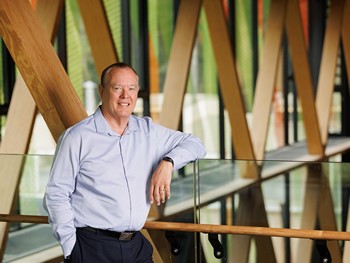Pioneering a sustainable bioeconomy for a greener tomorrow

New Zealand’s forests play a vital role in transitioning to a circular bioeconomy, aligning with priorities for sustainability, thriving communities and climate action.
I was in Australia recently, attending the biennial Australia-New Zealand Institute of Forestry (ANZIF) conference. The overall theme of the conference was Embracing our Natural Capital: The Science, Technology and Art of Managing Forests for All Values. Presentations strengthened my views on just how much advantage New Zealand’s forests give us in building tomorrow’s world. Their rapid growth rates will be vital for supplying the sustainable biomass that will grow New Zealand’s low-carbon economy.
As the world is responding to climate change and other environmental challenges, economies are looking to move away from the petrochemical economy to a circular bioeconomy. That move is about protecting the environment and helping meet our net-zero targets by taking more greenhouse gasses out of the atmosphere and locking them up, either in standing forests or by replacing products and materials based on fossil-fuels and petrochemicals with alternatives produced from sustainably grown biomass. A circular bioeconomy will see our forests and other sustainable biomass being made into new biomaterials including bioplastics, clothing, and the bioenergy and biofuels needed to fuel our low-carbon economy.
Scion is working to help New Zealand transition to a circular bioeconomy, right across our three impact areas and 11 research portfolios. It is an approach that aligns closely with a Te Ao Māori worldview which positions New Zealand with a globally unique value proposition. This is a huge economic opportunity for New Zealand. We can revitalise our rural communities with a mosaic of economic activity in our regions from farming, forestry and a myriad of new manufacturers creating the materials and products needed in a new circular bioeconomy. Compared to petrochemical industries these new approaches work at smaller scales that fit better with New Zealand’s size and landscape.
New Zealand’s future is at risk. Economically, we’re already seeing this in climate-related disruptions to global supply chains. Climate change is accelerating and intensifying the impact of weather-related hazards. While climate change is a direct threat to New Zealand, if we act decisively we can turn this into a once-in-a-generation economic opportunity. Scion’s science and innovation can be the game changer to help make that happen.
Scion can’t do that alone, and we need a future-fit science and innovation system if Scion and others are to deliver on government expectations and serve Aotearoa to the best of our ability.
At the ANZIF conference in October, there was plenty of discussion about Australia’s national research priorities. The Australian Government has proposed four of these: ensuring a net-zero future and protecting Australia’s biodiversity; supporting healthy and thriving communities; enabling a productive and innovative economy; and building a stronger, more resilient nation. The priorities focus more on broad societal goals than on the mechanisms for achieving them, and one of the speakers at the ANZIF conference summarised those national priorities in the following points:
- Transforming landscapes at scale
- Incentivising bioeconomy transitions
- Delivering circular economy objectives
- Diversifying regional economies
That summary resonates strongly with me, and with the work that Scion is doing. Here in New Zealand, we need to get in with this journey or be left behind. In a constrained fiscal environment, it is even more important that the governmentfunded research, science and innovation system has more of its funding aligned to delivering on these great opportunities for our country and our communities. We want to set outcomes to be delivered and to be supported – and held to account – for delivering them.

Dr Julian Elder
Chief Executive
